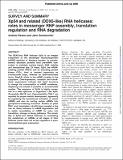Files in this item
Xp54 and related (DDX6-like) RNA helicases : roles in messenger RNP assembly, translation regulation and RNA degradation
Item metadata
| dc.contributor.author | Weston, A | |
| dc.contributor.author | Sommerville, John | |
| dc.date.accessioned | 2013-12-05T13:01:01Z | |
| dc.date.available | 2013-12-05T13:01:01Z | |
| dc.date.issued | 2006-07 | |
| dc.identifier | 361364 | |
| dc.identifier | c7cdab6d-2b35-4933-af5d-c502035bb3e8 | |
| dc.identifier | 000239430900022 | |
| dc.identifier | 33745159015 | |
| dc.identifier.citation | Weston , A & Sommerville , J 2006 , ' Xp54 and related (DDX6-like) RNA helicases : roles in messenger RNP assembly, translation regulation and RNA degradation ' , Nucleic Acids Research , vol. 34 , no. 10 , pp. 3082-3094 . https://doi.org/10.1093/nar/gkl409 | en |
| dc.identifier.issn | 0305-1048 | |
| dc.identifier.uri | https://hdl.handle.net/10023/4273 | |
| dc.description.abstract | The DEAD-box RNA helicase Xp54 is an integral component of the messenger ribonucleoprotein (mRNP) particles of Xenopus oocytes. In oocytes, several abundant proteins bind pre-mRNA transcripts to modulate nuclear export, RNA stability and translational fate. Of these, Xp54, the mRNA-masking protein FRGY2 and its activating protein kinase CK2 alpha, bind to nascent transcripts on chromosome loops, whereas an Xp54-associated factor, RapA/B, binds to the mRNP complex in the cytoplasm. Over-expression, mutation and knockdown experiments indicate that Xp54 functions to change the conformation of mRNP complexes, displacing one subset of proteins to accommodate another. The sequence of Xp54 is highly conserved in a wide spectrum of organisms. Like Xp54, Drosophila Me31B and Caenorhabditis CGH-1 are required for proper meiotic development, apparently by regulating the translational activation of stored mRNPs and also for sorting certain mRNPs into germ plasm-containing structures. Studies on yeast Dhh1 and mammalian rck/p54 have revealed a key role for these helicases in mRNA degradation and in earlier remodelling of mRNP for entry into translation, storage or decay pathways. The versatility of Xp54 and related helicases in modulating the metabolism of mRNAs at all stages of their lifetimes marks them out as key regulators of post-transcriptional gene expression. | |
| dc.format.extent | 13 | |
| dc.format.extent | 1000539 | |
| dc.language.iso | eng | |
| dc.relation.ispartof | Nucleic Acids Research | en |
| dc.subject | DEAD-BOX PROTEIN | en |
| dc.subject | PHYSIOLOGICAL GERMLINE APOPTOSIS | en |
| dc.subject | CYTOPLASMIC PROCESSING BODIES | en |
| dc.subject | STORED MRNP PARTICLES | en |
| dc.subject | Y-BOX | en |
| dc.subject | SACCHAROMYCES-CEREVISIAE | en |
| dc.subject | XENOPUS-OOCYTES | en |
| dc.subject | TRANSCRIPTION FACTOR | en |
| dc.subject | DNA-DAMAGE | en |
| dc.subject | RCK/P54 | en |
| dc.title | Xp54 and related (DDX6-like) RNA helicases : roles in messenger RNP assembly, translation regulation and RNA degradation | en |
| dc.type | Journal article | en |
| dc.contributor.institution | University of St Andrews. School of Biology | en |
| dc.identifier.doi | https://doi.org/10.1093/nar/gkl409 | |
| dc.description.status | Peer reviewed | en |
This item appears in the following Collection(s)
Items in the St Andrews Research Repository are protected by copyright, with all rights reserved, unless otherwise indicated.

